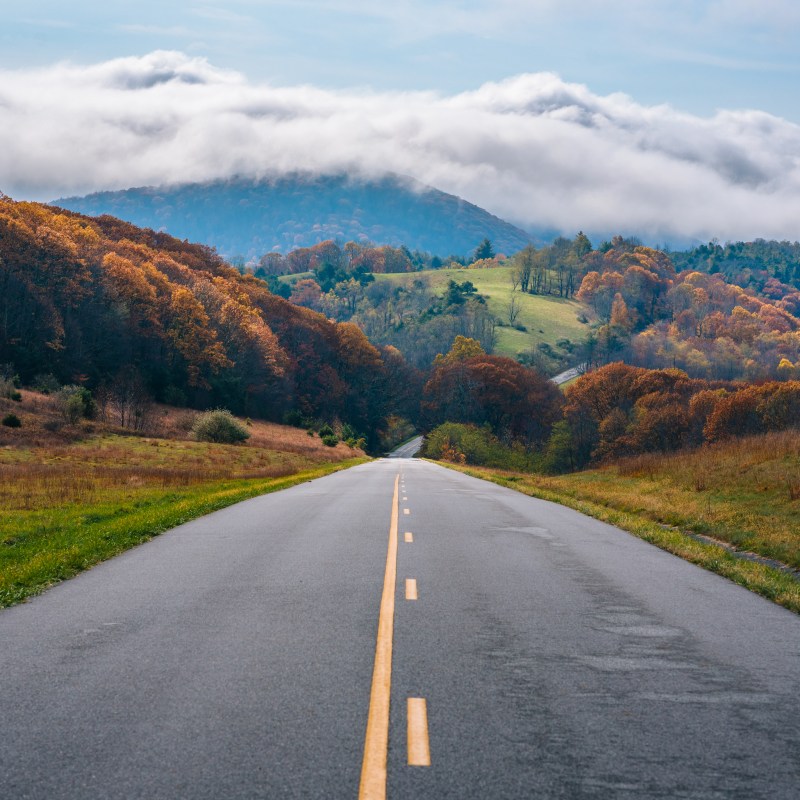
North Carolina is beautiful any time of year but, in the fall when the trees change colors, it’s especially breathtaking. Visitors come from all over the world to experience the millions of trees dressed in their glorious hues of yellows, oranges, and reds. Over 200 species of trees welcome the autumn season with their myriad of changing, vibrant colors.
Videos by TravelAwaits
Where are the best places in North Carolina to see fall foliage? Hands down, the Blue Ridge Mountains top the list. They offer one of the most colorful and longest-running fall foliage seasons in the world. Vibrant fall colors last for more than a month here. The color change starts in the higher elevations in October and works its way down to the lower elevations throughout November. Use this WNC fall color map for peak color times.
Not to be outdone by its western counterpart, the Piedmont offers plenty of leaf-peeping opportunities of its own. The Piedmont region of North Carolina lies between the foothills and the coastal region. This area offers numerous state parks and national forest areas for some of the best vibrant autumn colors in the state. Listed below are just some of the many great places to witness all the best colors of fall in North Carolina.

1. Blue Ridge Mountains
Located in Western North Carolina, the Blue Ridge Parkway runs south from the Virginia border, past Asheville, to Cherokee — more than 200 miles with over 100 tree varieties. The intensity of fall colors on the Parkway varies and is dependent on weather conditions. The best thing to do is grab your camera, hop on the Blue Ridge Parkway, and drive. You might be asking, “But where exactly?”
There is any number of starting and ending points to the Blue Ridge Parkway. We’ll break the drive down into three portions for ease, with the final coming in the next section of this article — it is actually in the Great Smoky Mountains, a subset of the Blue Ridge Mountains. There is ample opportunity to witness Mother Nature in her fall wardrobe on any of these routes, starting with the northernmost section near Cumberland Knob, close to the Virginia border. North Carolina Highways 89, 18, and the Blue Ridge Parkway all intersect north of Cumberland.
Cumberland Knob To Blowing Rock
The Cumberland Knob section of the Parkway runs south to the town of Blowing Rock for about 74 miles.
As with any route on the Blue Ridge Parkway, there are many ideal spots to pull over for beautiful autumn picture taking. Little Glade Mill Pond is a scenic little spot surrounded by trees. If the sun is just right, you can photograph the autumn leaves reflecting in the pond. The vistas are spectacular at Mahogany Rock and Air Bellows Overlooks, as they are at most of the overlooks. There are many small communities just off the parkway throughout this section including one of our favorite towns, Boone, named for the legendary Daniel Boone.
The Blowing Rock, North Carolina’s oldest travel attraction, is 3 miles off the parkway, southeast of the town of Blowing Rock on U.S. Route 321. You will find spectacular 360-degree views filled with dazzling fall foliage. Depending on how many stops you make — and there are many — this drive, one way, will be at minimum an hour and 45 minutes.
If your journey ends in Blowing Rock, there are several eateries in the town where you can have a scrumptious lunch or dinner before heading home. One of our favorite places here is Six Pence Pub, which serves traditional American and British comfort foods along with a variety of ale.

Blowing Rock To Asheville
The middle section of the Parkway takes you from Blowing Rock to Asheville, about 92 miles. A great little sightseeing spot with lots of foliage for pictures is Price Lake. There is a nice, easy 2-mile trail around the lake that is mostly flat.
Other viewing areas along this section are numerous and include Grandfather Mountain Overlook, Linn Cove Viaduct, and Linville Falls. From the town of Little Switzerland, you can see several mountain peaks, including Mount Mitchell, Table Rock, and Grandfather Mountain. The stretch from Blowing Rock to Asheville takes about 3 hours, again depending on how many stops you make.

In Asheville, whether starting or ending your trip, be sure to stop in at the Blue Ridge Parkway Visitor Center for maps, information, and souvenirs. There are many great places to eat while in and around Asheville. For more fall fun, visit one of the many nearby Hendersonville apple orchards. Refresh yourself at one of the wineries or breweries along the Cheers Trail.
Did I mention people come to the parkway from all over the world? Weekends tend to be pretty crowded, as can weekdays during peak color times. Bring your patience with you. Drive slowly. Watch out for other visitors in vehicles or on foot. There even may be bicyclists on the road.

2. Great Smoky Mountains
A subset of the more well-known and popular Blue Ridge Mountains, the Western North Carolina Great Smoky Mountains are magical in the fall. With 18 mountain peaks that stand at over 6,000 feet in elevation, you will see some of the most incredible long-range views of autumn’s majesty in North Carolina.
This final section of the Blue Ridge Parkway drive is 90 miles from Asheville south to Cherokee. Like the other two sections of the parkway, there are numerous places to pull over to view the colors of fall. One fun spot is the Devil’s Courthouse Overlook. From here you can look up through the foliage to the 5,720-foot Devil’s Courthouse pinnacle. A bit down the road is the Courthouse Valley Overlook, where you can see trees in all their fall dressings for miles and miles.
A stop at Waterrock Knob Overlook sits at almost 6,000 feet and boasts 360-degree views. There are picnic areas, restrooms, and a visitor center at this stop. Plus a moderate 1.2-mile hiking trail that takes you to the summit for even more spectacular views.
The Waynesville Overlook has a particularly beautiful view looking west and is worth the stop. There are several more stops, including some overlooking Maggie Valley, all with spectacular views. At the end of the parkway, on U.S. Highway 421, is historical Mingus Mill, one of the most photographed places during fall leaf season. Near Cherokee, two of North Carolina’s most beautiful waterfalls are nestled in the foliage, Mingo Falls and Soco Falls. Depending on how often you stop and for how long, driving this Smoky Mountains portion of the Blue Ridge Parkway will take about 3 hours.
Pro Tips For Exploring The Blue Ridge Parkway
There are many overlooks, pull-outs, and parking places along the Blue Ridge Parkway. You can view the vast, colorful vistas within a few feet from your vehicle from many of them. Some require a short walk to the viewing area. The trails can have uneven ground, rocks, rocks, and boulders. Be sure to wear sturdy shoes.
Mornings in the North Carolina mountains can be chilly, so dress in layers. Bring a light jacket. It can get cold and windy on the overlooks.
Stops with food and facilities — that is, bathrooms — are few and far between. Pack a picnic and/or bring snacks for the drive. There are several picnic areas along the roadside as well as the overlooks. Bring toilet paper (or napkins), hand sanitizer, and plastic bags just in case you need to use a tree. Trust me, people do. Be sure to take out all trash with you. Leave nothing behind.
3. Hanging Rock State Park
Hanging Rock State Park is 30 miles north of Winston-Salem. The park has more than 7,000 acres set in the Sauratown Mountains. Peaks here reach 2,500 feet There are waterfalls, streams, and a lake. Hiking is a fantastic way to view the fall leaves. Many of the trails here are moderate to strenuous, but there are a couple “easy” trails for strolling. The lake has great picture-taking angles. The picnic area near the lake has drinking water, restrooms, and wheelchair-accessible picnic tables.

4. Pilot Mountain State Park
Pilot Mountain State Park is located northwest of Winston-Salem, just of U.S. Route 52 in Surry and Yadkin counties. Hiking, biking, and rock climbing are popular at Pilot Mountain. The most popular spot, of course, is the summit. The views from the peak are spectacular. This is especially true during leaf season in the fall. On weekends, visitors can drive to the peak from 7 a.m. to 10 a.m.
A shuttle from the visitor center to the summit parking lot is available on weekends and holidays from March to November. It is wheelchair accessible, as is the overlook at the summit parking area. The park’s picnic area has an accessible path, and accessible parking is provided at the summit and at the visitor center.
In North Carolina’s Yadkin Valley, you might enjoy seeing the fall foliage while wine-tasting along the Surry County Wine Trail.
5. Uwharrie National Forest
Uwharrie National Forest in the North Carolina Piedmont is great for late-season leaf viewing because of its lower elevation. The forest covers over 50,000 acres and includes the Uwharrie Mountain Range, Yadkin and Pee Dee River basin, and Morrow Mountain State Park.
Hiking, biking, and other activities are plentiful, but this area is great for those that just want to leisurely drive to witness North Carolina’s fall foliage. There are many roads leading into and out of the forest. The main highways are I-74 to the east and U.S. Route 52 to the west. NC 27 runs through the forest east and west from Charlotte to Fayetteville.
Pro Tip: For the more adventurous leaf seekers, fly above the colorful canopies in a hot air balloon Asheville Balloon Company offers the fall viewing flights of a lifetime. Finally, for those who prefer to keep their feet on the ground, the Great Smoky Mountains Railroad in Bryson City, 10 miles south of Cherokee, offers a 4.5-hour Fall Foliage Train Ride. You can even order a box (car) lunch to enjoy on the train.
There are many incredible places to view foliage and experience the fall season in North Carolina. If you are a hiker, the possibilities are endless. See our picks for the most stunning hikes in North Carolina here.
